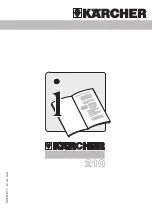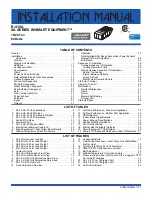
6
7
BEFORE FIRST USE
As received, your pressure cooker will be fully assembled. Following the instructions
below, disassemble the unit so you can thoroughly clean it, remove any manufacturing
lubricants, and become familiar with the various parts before initial use.
1. Remove the cover. Grasp the textured portion of the cover handle and rotate the cover
counterclockwise until the
INSTALL/REMOVE
vertical mark is within the mark
on the cooker body (Fig. B). Then lift the cover straight up off the cooker body.
Invert the cover and place it on the counter. Using the grip pin, pull the sealing ring
plate out from the cover (Fig. C). Remove the sealing ring from the sealing ring plate.
With the sealing ring plate detached from the cover,
you have access to the vent fi lter and vent pipe.
Next, remove the vent fi lter for cleaning.
NOTE:
Although you will not need to remove the fi lter
after every use, you should periodically remove it for
cleaning.
With the inverted cover on the counter, rest a
table knife on the rim of the cover and insert
the tip into one of the fi lter slots; lift the fi lter
up (Fig. D).
2. Lift the cooking rack and removable cooking
pot out of the cooker body.
3. Remove all packaging materials. Then clean
the cooker cover with a damp, soapy cloth.
Do
NOT immerse the cooker cover in water.
Wash the sealing ring plate, sealing ring, vent
fi lter, cooking rack, and removable cooking pot in warm,
soapy water. Rinse and dry thoroughly.
CAUTION!
Never pour water into the cooker body or
immerse it or the power cord in water. Always be sure
the cooking pot is COMPLETELY DRY before placing
it back in the cooker body.
4. After cleaning, reassemble the cover. When re-
attaching the vent fi lter, be sure the fi lter is placed over
all three clips (Fig E). Then push it in place. You will
hear a snap when it is in the proper position. It should
fi t tightly. Next, reattach the sealing ring to the plate
and then the sealing ring plate to the cover.
IMPORTANT:
When properly positioned, the grip pin
(Fig C) will be facing you. Grasp the grip pin and use it
to push the plate back in place. Check that the grommet
is securely positioned over the cover post.
IMPORTANT INFORMATION FOR EVERY USE
In order for the unit to function properly,
always
check the following before every use:
● Be sure the bottom of the removable cooking pot and the heating plate within the
cooker body (Fig. F) are free of debris before placing the cooking pot in the cooker
body.
CAUTION!
To prevent electrical shock, NEVER
USE THE UNIT WITHOUT THE REMOVABLE
COOKING POT. Also, be sure the outside of the cooking
pot is COMPLETELY DRY before placing it into the
cooker body.
● Check both the vent pipe and vent fi lter to be sure they are
clear. In order to do this, you will need to remove the quick
pressure release valve (Fig. G) and sealing ring plate (Fig
C) from the cover (see page 6).
Then hold the cover up to the light and make sure you
can see light coming through the vent pipe. If you cannot,
remove the vent fi lter (see page 6) and clean the vent pipe
with a small brush or pipe cleaner to remove the blockage.
Reattach the sealing ring plate to the cover.
● Always verify that the sealing ring plate is attached to the
pressure cooker cover before cooking.
● Make sure you have not overfi lled the cooking pot. Do not
fi ll above the ⅔ fi ll line when cooking most foods. When
cooking foods that foam, froth, or expand, such as rice,
grains, dry beans, peas, and lentils, or foods that are mostly
liquids, such as soups, never fi ll the cooking pot above the
½ fi ll line.
For your convenience, both the ⅔ and ½ fi ll lines are
marked inside of the cooking pot (Fig. H). In addition, in
each section of the recipes you will fi nd instructions on the
maximum fi ll level for each type of food.
● Always make sure cooking liquid has been added to the
cooking pot. One cup of liquid is the minimum amount.
● Always follow special procedures found in the instruction book when pressure
cooking dry beans, peas, and lentils (see page 30). During cooking, these foods tend
to froth and foam which could cause the vent pipe to become blocked.
● Never pressure cook applesauce, cranberries, rhubarb, cereals, pasta, split peas, and
dried soup mixes. These foods expand so much as a result of foaming and frothing
that they should never be cooked under pressure.
● Always follow the special procedures found on page 33 when pressure cooking rice
and grains.
Grip pin
Fig. C
Grommet
Cover post
Vent fi lter
Fig. D
Sealing ring
plate
Sealing
ring
Fig. B
Fig. E
Clips
Heating plate
Fig. F
Vent pipe
Fig. G
Quick pressure
release valve
½
line
⅔
line
Fig. H





































